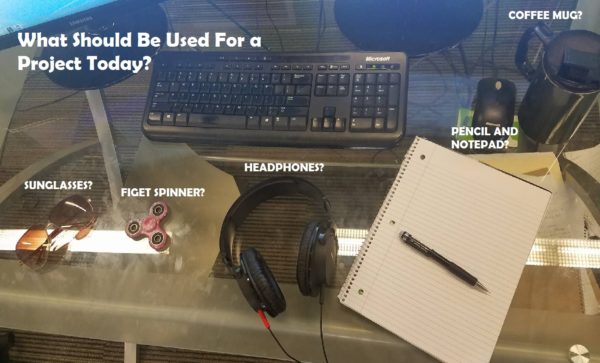In the past, I have admittedly spent a good deal of my time living in fear of oscilloscopes. They were just so big, clunky looking, and seemed intimidatingly complex. Historically whenever I was presented with a situation in which one would have been a possible solution, I just oscillonoped right out of there. But now I have decided to face my demons, to square up against the waves of fear, to not freak out at the mention of frequency. So I amped up my ‘tude , cali-braced myself, and accepted the idea that no matter how many puns I made I would eventually have to get on with actually learning the content.
With that in mind, I began my journey.
I should mention that for the duration of this learning experience I left my webcam on record so that I could later give Kaitlyn a “expressive review” of the setup process. I will be incorporating the images corresponding to the events of this post so you may truly enjoy the emotional experience that is getting started with this product.
After grabbing my own Analog Discovery 2 (you can get your own too from the Digilent Store!) I proceeded to make my way to the product’s homepage to learn what my next steps would be. Immediately the top right corner caught my eye.

Well I like quickness, and I do want to get started. This seems to be the place I need to be. After clicking over and proceeding with the unboxing, I moved right into step two- downloading the software.
Downloading WaveForms was so easy that I felt kind of uncomfortable with feeling as self-satisfied as I did about having breezed through the process. Honestly I had more trouble and spent more time plugging the flywires into the Analog Discovery itself, and by trouble I mean I tried to plug them in upside down, and by time I mean about eight tense seconds. But in the end, I managed to pass the first level of using the Analog Discovery 2.
Now on to the actual, you know, using part.
After plugging in my micro USB cable (correct side up this time, I am evolving) I opened WaveForms and was greeted with a hopeful looking loading bar pop up window…

Annnddddd then another pop up.

“PLL Not Locked”
Huh. A challenge has been issued. Tapping on my best IT wisdom, I unplugged the cable and plugged it back in again. Same error.
This means war.
Arming myself with information from the troubleshooting page, I scoured for possible solutions to the issue but I was unable to locate my specific problem. So I turned to the Diligent Forum. Fortunately since Kaitlyn was in today, this meant I turned around in my chair and asked for help loudly across the office.
After some examination and Kaitlyn-sorcery she diagnosed the problem as a broken device. It turns out the one I had grabbed laying around the office was the non-functioning one we kept around to take photos of.

Huh. If this is the universe attempting to instruct me that I was not meant to ever get the hang of using desktop instrumentation, then I would like to remind said universe that according to my mother and most of my teachers listening to directions is not my strong suit. I will figure this out.
After disposing of the offending device and trying again, I found success! I was able to easily proceed through step four of the Quick Start and take my first measurement using the Oscilloscope and the Waveform Generator!
I have now gotten the hang of setting up and doing my first trial run of an oscilloscope! I hold for applause, but people seem to be otherwise occupied. That’s okay. I know what really will serve showcase my newfound skill… a project!
I begin brainstorming and looking around my desk for inspiration.

I decide that my first project with my newfound knowledge will be a fidget spinner measurement device. The idea will be to use the Analog Discovery 2 to measure who can spin it the fastest because I think it will be a good way to explore using the oscilloscope function. Also I had been practicing this skill for about 3 days because I am the worst kind of person. I was hoping that my idea to use Analog Discovery 2 to measure the speed of a fidget spinner would demonstrate my honed fine motor skills as opposed to a complete misunderstanding of instrumentation tools and how to use them.
Stay tuned for next week’s installment where we see if the Master Fidget Spinner Plan succeeds!
